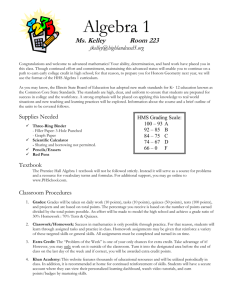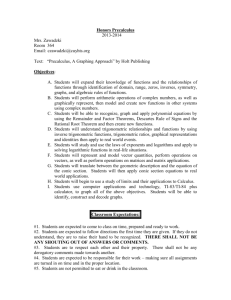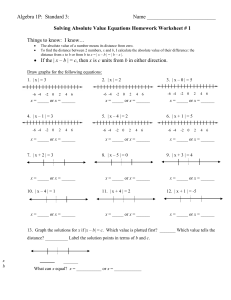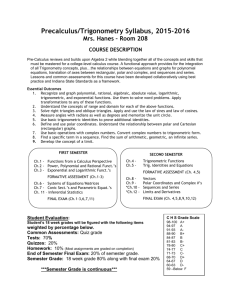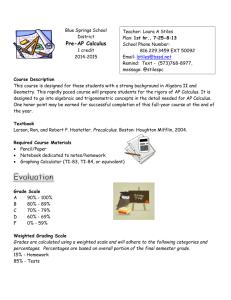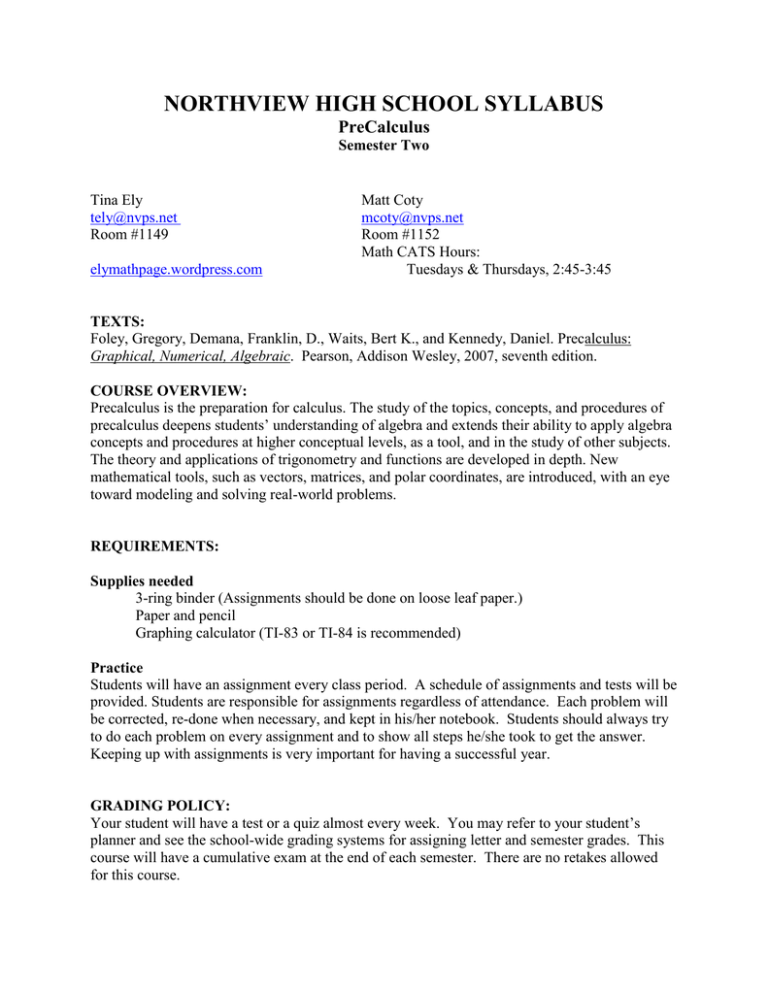
NORTHVIEW HIGH SCHOOL SYLLABUS
PreCalculus
Semester Two
Tina Ely
tely@nvps.net
Room #1149
elymathpage.wordpress.com
Matt Coty
mcoty@nvps.net
Room #1152
Math CATS Hours:
Tuesdays & Thursdays, 2:45-3:45
TEXTS:
Foley, Gregory, Demana, Franklin, D., Waits, Bert K., and Kennedy, Daniel. Precalculus:
Graphical, Numerical, Algebraic. Pearson, Addison Wesley, 2007, seventh edition.
COURSE OVERVIEW:
Precalculus is the preparation for calculus. The study of the topics, concepts, and procedures of
precalculus deepens students’ understanding of algebra and extends their ability to apply algebra
concepts and procedures at higher conceptual levels, as a tool, and in the study of other subjects.
The theory and applications of trigonometry and functions are developed in depth. New
mathematical tools, such as vectors, matrices, and polar coordinates, are introduced, with an eye
toward modeling and solving real-world problems.
REQUIREMENTS:
Supplies needed
3-ring binder (Assignments should be done on loose leaf paper.)
Paper and pencil
Graphing calculator (TI-83 or TI-84 is recommended)
Practice
Students will have an assignment every class period. A schedule of assignments and tests will be
provided. Students are responsible for assignments regardless of attendance. Each problem will
be corrected, re-done when necessary, and kept in his/her notebook. Students should always try
to do each problem on every assignment and to show all steps he/she took to get the answer.
Keeping up with assignments is very important for having a successful year.
GRADING POLICY:
Your student will have a test or a quiz almost every week. You may refer to your student’s
planner and see the school-wide grading systems for assigning letter and semester grades. This
course will have a cumulative exam at the end of each semester. There are no retakes allowed
for this course.
ASSESSMENTS:
Quizzes (1-2 per chapter): 100 points each
Chapter Tests (4 or 5 per semester): 200 points each
Exam (1 per semester) 20% of semester grade
SCHEDULE:
Chapter P
P.1
P.2
P.3
P.4
P.5
P.6
P.7
Real Numbers
Cartesian Coordinate Systems
Linear Equations and Inequalities
Lines in the Plane
Solving Equations Graphically, Numerically, and Algebraically
Complex Numbers
Solving Inequalities Algebraically
Chapter 1
1.1 Modeling and Equation Solving
1.2 Functions and Their Properties
1.3 Twelve Basic Functions
1.4 Building Functions from Functions
1.5 Parametric Relations and Inverses
1.6 Graphical Transformations
1.7 Modeling With Functions
Chapter 2
2.1
2.2
2.3
2.4
2.5
2.6
2.7
2.8
Linear and Quadratic Functions and Modeling
Power Functions with Modeling
Polynomial Functions of Higher Degree with Modeling
Real Zeroes of Polynomial Functions
Complex Zeroes and the Fundamental Theorem of Algebra
Graphs of Rational Functions
Solving Equations in One Variable
Solving Inequalities in One Variable
Chapter 3
3.1
3.2
3.3
3.4
3.5
3.6
Exponential and Logistic Functions
Exponential and Logistic Modeling
Logarithmic Functions and Their Graphs
Properties of Logarithmic Functions
Equation Solving and Modeling
Mathematics of Finance
Chapter 4
4.1 Angles and Their Measures
4.2
4.3
4.4
4.5
4.6
4.7
4.8
Trigonometric Functions of Acute Angles
Trigonometry Extended: The Circular Function
Graphs of Sine and Cosine: Sinusoids
Graphs of Tangent, Cotangent, Secant, and Cosecant
Graphs of Composite Trigonometric Functions
Inverse Trigonometric Functions
Solving Problems with Trigonometry
Review for the first semester exam and Exam
Chapter 5
5.1 Fundamental Identities
5.2 Proving Trigonometric Identities
5.3 Sum and Difference Identities
5.4 Multiple Angle Identities
5.5 The Law of Sines
5.6 The Law of Cosines
Chapter 6
6.1 Vectors in the Plane
6.2 Dot Products of Vectors
6.3 Parametric Equations and Motion
6.4 Polar Coordinates
6.5 Graphs of Polar Equations
Chapter 7
7.1 Solving Systems of Two Equations
7.2 Matrix Algebra
7.3 Multivariate Linear Systems and Row Operations
7.4 Partial Fractions
7.5 Systems of Inequalities in Two Variables
Chapter 8
8.1 Conic Sections and Parabolas
8.2 Ellipses
8.3 Hyperbolas
Chapter 9
9.1 Basic Combinatorics
9.2 The Binomial Theorem
9.3 Probability
Chapter 10
10.1 Limits and Motion: The Tangent Problem
10.2 Limits and Motion: The Area Problem
10.3 More on Limits


